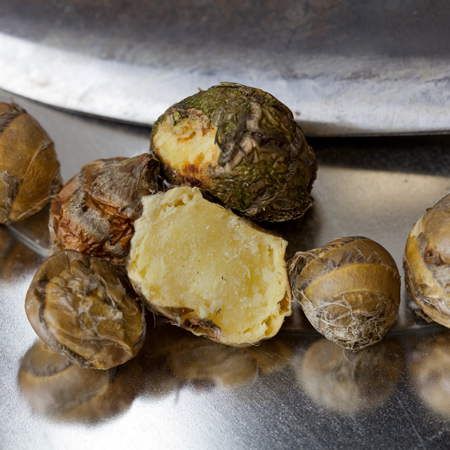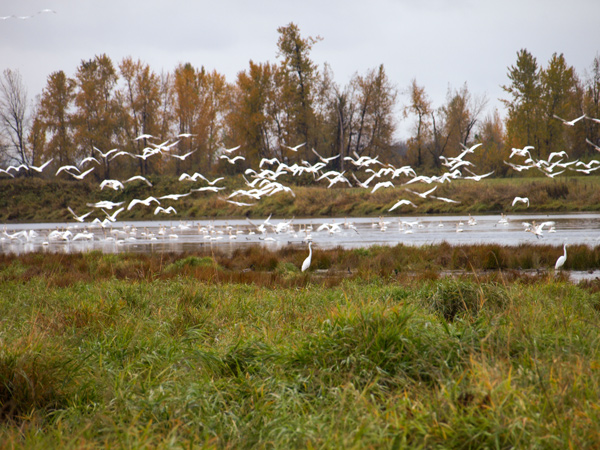Moving down the Columbia River, a Chinookan villager introduces the captains to the wapato bulb—a staple Native food. At camp near present Ridgefield, Washington, they are kept awake by noisy waterfowl.
Roasted Wapato
by Yellowstone Public Radio[1]Originally aired weekdays by Yellowstone Public Radio during the Bicentennial observance of 2003-2006. Narrated by Hal Hansen. Scripts by Whit Hansen and Ed Jacobson. Produced by Leni Holliman. © … Continue reading
Roasted Wapato Bulbs
Sagittaria latifolia
© 2012 by Kristopher K. Townsend. Permission to use granted under the Creative Commons Attribution-Share Alike 4.0 International license.
New Ecological System
I walked out on the Stard. Side found the country fine, an open Prarie for 1 mile back of which the wood land comence riseing back, the timber on the edge of the Prarie is white oke, back is Spruce pine & other Species of Pine mixed Some under groth of a wild crab & a Specis of wood I’m not acquainted, a Specis of maple & Cotton wood grow near this river, Some low bushes
—William Clark
Mt. St. Helens
passed a [Multnomah] village of four large houses on The Lard. Side, near which we had a full view of Mt. Helien which is perhaps the highest pinical in America from their base it bears N. 25° E about 90 miles— This is the mountain I Saw from the Muscle Shell rapid on the 19th of October last Covered with Snow, it rises Something in the form of a Sugar lofe—
—William Clark
Wapato
We landed at a [Watlala] village 200 men of Flatheads of 25 houses 50 canoes built of Straw, we were treated verry kindly by them, they gave us round root near the size of a hens egg roasted which they call Wap-to [wapato] to eate . . . . which they roasted in the embers until they became Soft
—William Clark
Snow Geese Take Flight
Ridgefield National Wildlife Refuge, 9 November 2008. © by Kristopher K. Townsend. Permission to use granted under the Creative Commons Attribution-Share Alike 4.0 International license.
Noisy Waterfowl
A cloudy cool morning wind from the West
opposite to our camp on a Small Sandy Island the brant & geese make Such a noise that it will be impossible for me to Sleap.
—William Clark
Thieves
dureing the time we were at dinner those fellows Stold my pipe Tomahawk which They were Smoking with, I imediately Serched every man and the canoes, but Could find nothing of my Tomahawk, while Serching for the Tomahawk one of those Scoundals Stole a Cappoe [Capote] of one of our interpreters
—William Clark
Weather Diary
Day of the month Wind State of the Weather 4th W. cloudy after rain —Meriwether Lewis[2]Some abbreviations have been spelled out.
Ridgefield National Wildlife Refuge is a High Potential Historic Site along the Lewis and Clark National Historic Trail managed by the U.S. National Park Service. In addition to wildlife viewing, the Cathlapotle plankhouse re-construction is also located here.
Notes
| ↑1 | Originally aired weekdays by Yellowstone Public Radio during the Bicentennial observance of 2003-2006. Narrated by Hal Hansen. Scripts by Whit Hansen and Ed Jacobson. Produced by Leni Holliman. © 2003 by Yellowstone Public Radio. |
|---|---|
| ↑2 | Some abbreviations have been spelled out. |
Experience the Lewis and Clark Trail
The Lewis and Clark Trail Experience—our sister site at lewisandclark.travel—connects the world to people and places on the Lewis and Clark Trail.
Discover More
- The Lewis and Clark Expedition: Day by Day by Gary E. Moulton (University of Nebraska Press, 2018). The story in prose, 14 May 1804–23 September 1806.
- The Lewis and Clark Journals: An American Epic of Discovery (abridged) by Gary E. Moulton (University of Nebraska Press, 2003). Selected journal excerpts, 14 May 1804–23 September 1806.
- The Lewis and Clark Journals. by Gary E. Moulton (University of Nebraska Press, 1983–2001). The complete story in 13 volumes.





